Forbidden Sky delivers cooperative science
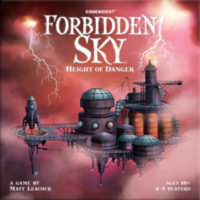
You’ve rescued treasure from a sinking island and recovered a legendary flying machine from the desert — now it’s time to power up a rocket from a platform in the clouds 7,000 feet above the ground.
In order to do so, you’ll have to work together as a team to wire together capacitors and lightning rods in a true electrical circuit with the launch pad!
This third installment in the “Forbidden” series of cooperative games is more than just playing with tiles on a table. Players now must create an actual electrical circuit in order to win.
We’ve raved about both Forbidden Island and Forbidden Desert over the years because their fantastic cooperative play for families. Forbidden Island was one of the first cooperative games we reviewed in 2010. And Forbidden Desert stepped up the difficulty a few years later with shifting tiles being buried in layers of sand.
In Forbidden Sky designer Matt Leacock and publisher Gamewright have stepped up the difficulty yet again. This time around players are building the platform as they play and placing electrical components to form a circuit with the launch pad.
Are you up for the tougher challenge?
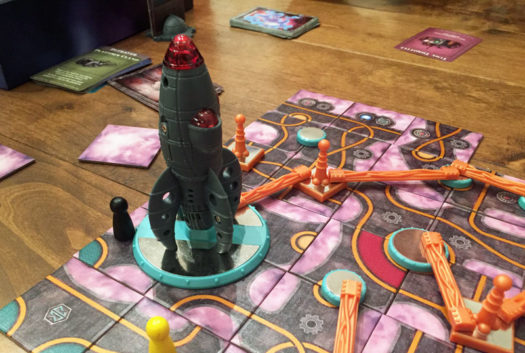
How to play Forbidden Sky
Like in typical “Forbidden” game, you’ll begin by selecting their Adventurer role (random or by choice) and taking that role card. Place a clip on the left of your card at the top of your Health marks and a clip on the right at the top of your Rope marks.
Set the starting Storm Intensity level based on the number of players and shuffle the different card decks: Storm and Equipment. Mix up all the platform tiles face down and place them in a stack to form the platform draw pile. Each player draws one platform tile to start with. These are kept face up in front of you.
Then choose your level of difficulty (Novice, Normal, Expert, Legendary) and set out the indicated number of each type of component shown on that blueprint card. Lastly, set out the starting platform grid with the wind indicator pointing toward the landing platform and placing a lighting rod on the indicated space.
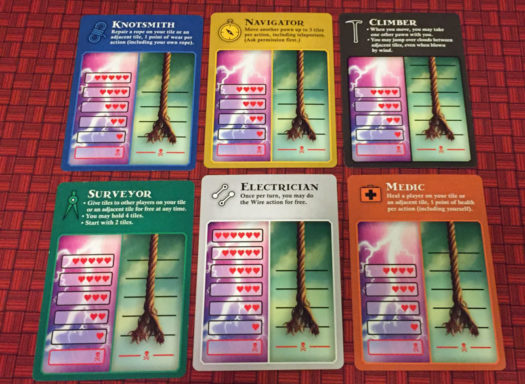
In typical “Forbidden” fashion, you’ll take up to 4 Actions on your turn followed by drawing cards that have bad things happen — this time it’s the Storm deck.
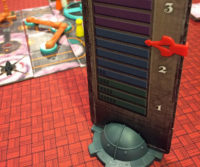
On your turn, you can select any combinations of the following actions:
- Move: You may move on the platform in any orthogonal direction as long as the platform is connected between those tiles. You can also move between Teleporter tiles for one movement action.
- Scout: Draw one tile from the platform draw stack. You can’t have more than 3 platform tiles in front of you at a time.
- Explore: Place one of your tiles on an adjacent location to the spot your pawn is on. At least one printed wire on the added tile must connect to a printed copper wire on your current tile. If the tile has a lightning rod symbol on it, you must place a lightning rod on that spot. If the tile placed completes a circle filled with color, place the corresponding circuit component on it. If the tile you place has a Gear symbol on it, draw an Equipment card. These cards will grant special abilities throughout the game.
- Wire: Add a physical wire to a circuit component attached to your tile so it connects to another circuit component. You can also use this action to remove a wire. Each component can have up to two wires connecting to it. To complete the full circuit, the launch pad must have a wire touching each metal side.
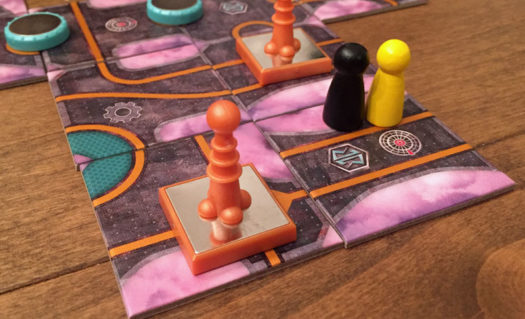
After you take your turn, you draw a number of cards from the Storm deck as indicated on the Storm Intensity meter — resolving each as its drawn.
There are 4 different types of Storm cards:
- Lightning Strikes: Every lightning rod in the game is hit by lightning. Each player on a lightning rod tile is hit and reduces their Health by 1 mark. In addition, the electricity flows to all tiles connected by wire (either printed or by physically connected wire). Players on those connected tiles also lose 1 Health.
- Winds Change: Rotate the arrow on the wind compass 90 degrees in the direction shown on the card.
- High Winds: All player pawns are blown one tile in the direction shown by the wind compass. If a player can’t be blown to an adjacent tile (because it’s into the clouds or off the platform), their Rope gets worn. They must reduce their Rope by 1 mark.
- Storm Intensifies: Players move the Storm Intensity meter up one mark.
Some tiles include symbols that protect players from lightning and wind. Tiles with the Faraday Cage protect players from lighting jolts. And tiles with the Wind Shelter protect players from being blown in High Winds.
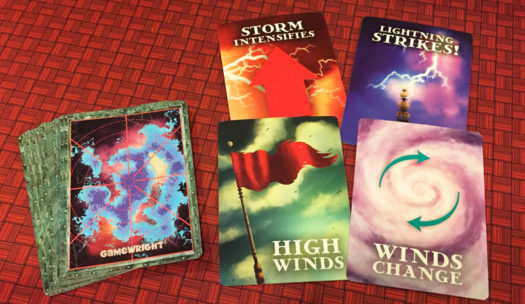
In order to win, a full circuit must be completed with the minimum number of components indicated on the difficulty blueprint card chosen. You can use more components than required, but must at least use the minimum listed on the blueprint.
As soon as the last wire is placed, the rocket will take off — with actual lights and sounds. So make sure all player pawns are on one of the tiles with the launch pad before placing the last wire in order to win. Otherwise, adventurers will be left behind and you’ll lose the game.
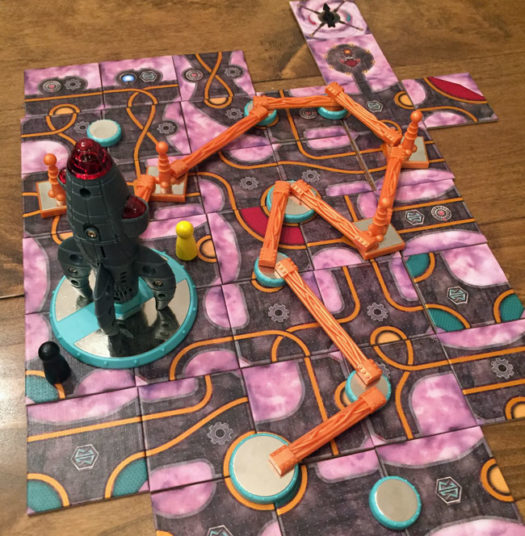
Not having all Adventurer pawns on one of the launch pad tiles when the circuit is completed is only one way you can lose the game.
There are 3 other ways you can lose the game as well. If any player reaches the bottom of either their Health or Rope marks, you’ll lose. Or if the Storm Intensity meter reaches the top mark.
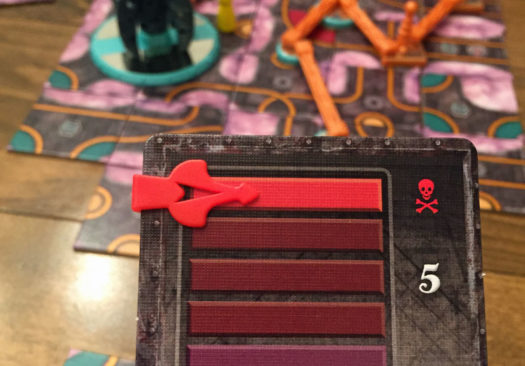
Can the whole family enjoy Forbidden Sky?
Like its predecessors, Forbidden Sky is a fun game for families to play together. Because it’s a cooperative game, both young and old players alike can enjoy the game.
And since Forbidden Sky has players creating an actual wired circuit, the science aspect is a big draw for kids as well.
However, Forbidden Sky is the most challenging of the three “Forbidden” games.
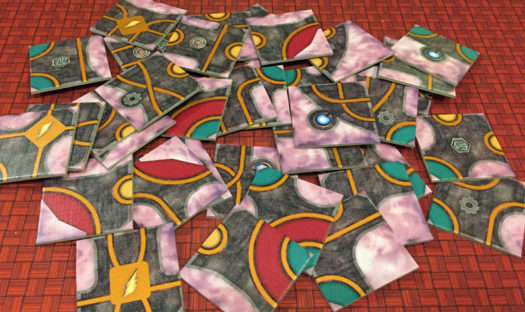
The first challenge is Scouting out all the tiles needed to to place the circuit components on the board. The next challenge is arranging them in such a way that they’ll be placed in locations that let you make a full circuit. And this all happens while you’re being electrocuted and blown around the platform from the Storm cards.
It all adds up to a tough challenge that requires a ton of teamwork.
Yet we still really enjoy the challenge and believe other families will too.
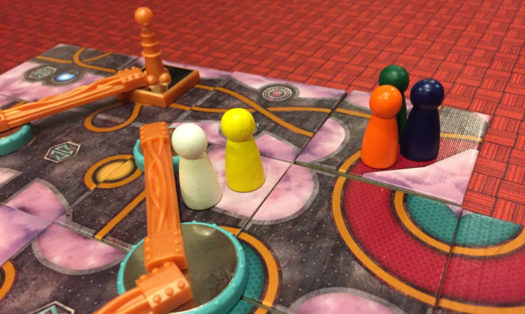
Players familiar with Forbidden Island and Forbidden Desert will recognize a lot of similarities between those and Forbidden Sky. These familiar elements are very welcome when diving into a new game. However, the unique elements of Forbidden Sky truly make the game playing experience stand on its own.
For starters, the familiar element of different player roles with their special abilities is extremely helpful. While there are 6 different roles in the game, the maximum player count is 5. So every time you play, you’ll be limited in which special abilities will help you along the way.
The Electrician can connect a wire for free on their turn. The Surveyor can hold up to 4 platform tiles in hand and can give them to other players on their tile or adjacent tiles for free at any time. The Knotsmith can repair damaged ropes of players on their tile or adjacent tiles. The Navigator may move another player 3 tiles per action. The Medic can heal players on their tile or adjacent tiles. And the Climber can jump over clouds that appear between two adjacent platform tiles and can take other players with him whenever he moves.
With the amount of havoc the Storm cards can hammer players with, these special role abilities are lifesavers. The challenge is how to make due without the special ability of the roles you’re not playing with each game.
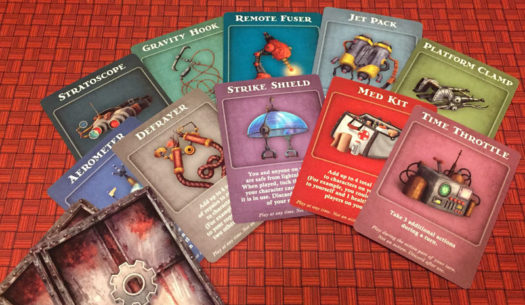
It’s great that there are multiple difficulty levels. But even the Normal level is quite the challenge itself. Most of our games played at the Normal level have ended in failure one turn away from winning. So close, but so far.
While the other games in the series begin with a grid of tiles forming the play area, in Forbidden Sky players build the board as they go. The good news is that players can hold up to 3 tiles in hand and they keep them face up throughout the game. This way, all players can see the various tiles held by everyone and can better work together on how to build out the connecting platforms.
This comes in very handy when figuring out where to place tiles that will complete colored circles to place circuit components.
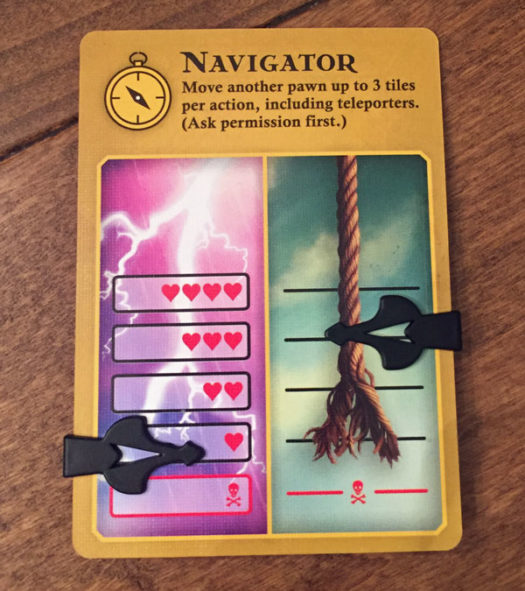
Every game will play out differently because of when different tiles get revealed and played. So while the final platform layout won’t be very expansive, it will always be different. And there’s fun in that variability.
There’s also something very fun about creating a physical circuit that launches a toy rocket with all the lights and sounds. When you complete the circuit and the rocket starts lighting up and making blast off sounds, it’s very rewarding!
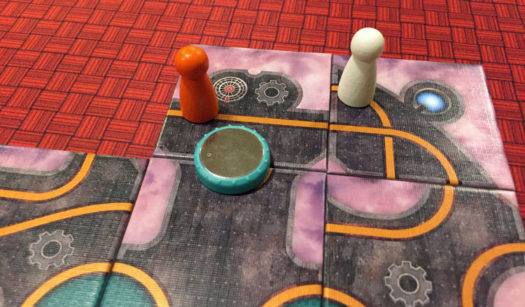
How does Forbidden Sky score on our “Let’s Play Again” game meter?
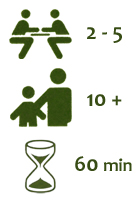 While we haven’t played any back-to-back games of Forbidden Sky, it still scores well on our “let’s play again” game meter because of its engaging cooperative play.
While we haven’t played any back-to-back games of Forbidden Sky, it still scores well on our “let’s play again” game meter because of its engaging cooperative play.
That being said, it also falls into third place in our ranking of the “Forbidden” games. Our favorite is still Forbidden Desert. We love the shifting tiles and tiles getting buried in the sand. It’s got a lot of variability and challenge at the same time. But it’s not an overwhelming challenge.
Forbidden Island comes in second for us because of its simplicity and short play time. That’s what we’ll go to when introducing new families to cooperative games.
When we’re up for a bigger cooperative challenge that plays in a hour, then Forbidden Sky will hit the table.
The good news is that each game is a standalone game. You don’t need one in order to play the others. So you can choose the one that fits your family best.
We’d like to thank Gamewright for a review copy of Forbidden Sky.



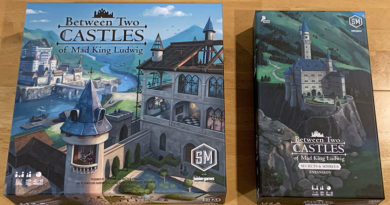
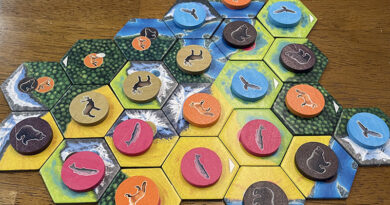
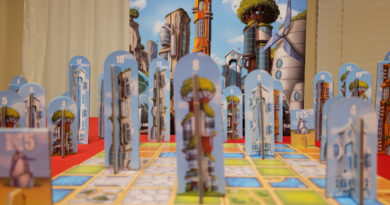
Thanks for the review. I was super excited when I saw the initial announcement for Forbidden Sky many months ago. We enjoy a bit of Forbidden family fun at my house from time to time. I’m not sure if the increased difficulty would be off-putting to family members or not. The concept of building up the platform during play is intriguing but I worry family members might get frustrated if they lost time and again because they couldn’t get the right tiles placed. While this is similar to the idea of needing to draw the right cards in the earlier version, I’d be concerned that this might be too much frustration.
Still, I’m super interested to try it out and see how everything works together. I love the thematic idea of the lightning and the rope. Very cool. With regards to the lightning, were your circuits ever so convoluted that it felt onerous to try and track the lightning from the lightning rods to identify which players might get hit? (And on a related note, can a player lose more than one health point if they happen to be on a tile that could be zapped by multiple lightning bolts?)
I was a little bummed by the price tag (I liked the lower price point of the other Forbidden games). While the rocket sounds cool, it seems like the electrical wow-factor is the main reason for the increased price (I could be wrong).
I want to try this out but I suspect I may end up with a similar ranking of the Forbidden games…putting this one at the end. I could be wrong. We shall see.
Chris – The good thing about placing the right tiles is that usually everyone has 2 or 3 tiles in front of them so everyone can explore the options and hold of on placing certain tiles in valuable locations because another player can place a better one on their turn. So we find a lot of discussion around who should move where to place certain tiles. (Then we get blown around and have to adjust.) The circuits are very easy to follow to determine who gets hit since the total size of the platform remains relatively small. And you can only get zapped once per lightning card.
Maybe I’ll have to bring it to SaltCon…
That makes sense (both the holding multi-tiles and size of the platform). Probably few cases of turns where there’s not an optimal placement or you feel like you have to spend multiple turns moving all the way across the table to place the tile.
Thanks Trent. 🙂
I just bought/played Sky last night. It was definitely more challenging than the previous games but also more rewarding. I love it!
However, the rules weren’t specific enough for us about the Surveyor’s special skill (just two of us and we were Surveyor and Electrician). When that character has the opportunity to provide another player with free tiles, do the tiles come from their hand or the deck? Since the number of tiles we can have in our hand at any given time is so limited, we assumed the deck.
Summer – the Surveyor gives tiles from their hand of tiles. The Surveyor also starts with 2 tiles and can hold up to 4 tiles in their hand. Thus, they’ll can have more to choose from when giving tiles away.